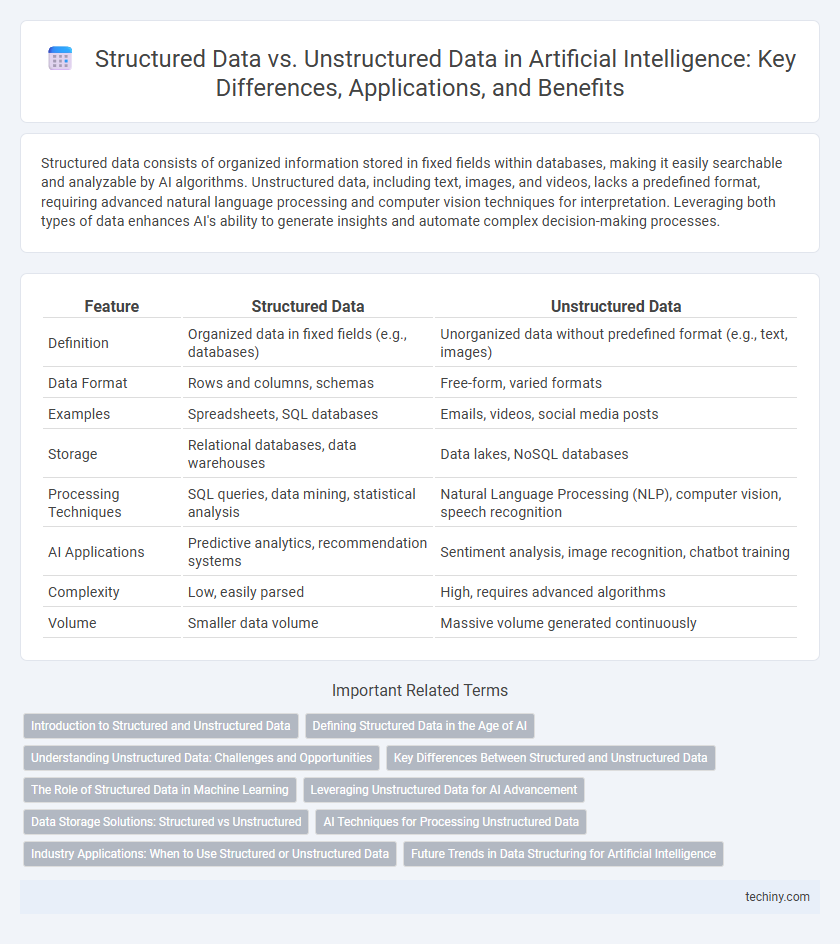Structured data consists of organized information stored in fixed fields within databases, making it easily searchable and analyzable by AI algorithms. Unstructured data, including text, images, and videos, lacks a predefined format, requiring advanced natural language processing and computer vision techniques for interpretation. Leveraging both types of data enhances AI's ability to generate insights and automate complex decision-making processes.
Table of Comparison
| Feature | Structured Data | Unstructured Data |
|---|---|---|
| Definition | Organized data in fixed fields (e.g., databases) | Unorganized data without predefined format (e.g., text, images) |
| Data Format | Rows and columns, schemas | Free-form, varied formats |
| Examples | Spreadsheets, SQL databases | Emails, videos, social media posts |
| Storage | Relational databases, data warehouses | Data lakes, NoSQL databases |
| Processing Techniques | SQL queries, data mining, statistical analysis | Natural Language Processing (NLP), computer vision, speech recognition |
| AI Applications | Predictive analytics, recommendation systems | Sentiment analysis, image recognition, chatbot training |
| Complexity | Low, easily parsed | High, requires advanced algorithms |
| Volume | Smaller data volume | Massive volume generated continuously |
Introduction to Structured and Unstructured Data
Structured data consists of highly organized information formatted in rows and columns, allowing easy storage, search, and analysis using traditional databases and algorithms. Unstructured data, lacking a predefined model, includes text, images, videos, and social media content, requiring advanced AI techniques such as natural language processing and computer vision for meaningful interpretation. Understanding the differences between these data types is crucial for optimizing machine learning models and enhancing data-driven decision-making processes.
Defining Structured Data in the Age of AI
Structured data in the age of AI refers to information organized in predefined formats such as databases, spreadsheets, or tables, enabling easy access and analysis by algorithms. This data type includes numerical values, dates, and categorical variables, making it highly suitable for machine learning models that require consistent input. Leveraging structured data allows for more accurate predictions, efficient data processing, and improved decision-making in AI-driven applications.
Understanding Unstructured Data: Challenges and Opportunities
Unstructured data, comprising over 80% of enterprise information, includes text, images, audio, and video that lack a predefined format, posing significant challenges for traditional AI models which thrive on structured data. Advances in natural language processing (NLP) and deep learning enable AI systems to extract meaningful patterns and insights from unstructured data, transforming it into actionable intelligence. Leveraging unstructured data offers opportunities for enhanced customer sentiment analysis, fraud detection, and predictive analytics across industries.
Key Differences Between Structured and Unstructured Data
Structured data is highly organized, residing in fixed fields within databases, facilitating easy search, analysis, and machine learning model training. Unstructured data lacks a predefined format, includes text, images, and videos, and requires advanced techniques like natural language processing and computer vision for interpretation. The key differences lie in data format, storage methods, processing complexity, and the types of AI algorithms needed to extract meaningful insights.
The Role of Structured Data in Machine Learning
Structured data, organized into predefined formats such as tables and spreadsheets, plays a crucial role in machine learning by enabling efficient data processing and accurate model training. Machine learning algorithms leverage structured data's clarity and consistency to identify patterns, make predictions, and improve decision-making processes. The quality and organization of structured data significantly impact the performance and reliability of AI systems across various industries.
Leveraging Unstructured Data for AI Advancement
Unstructured data, including text, images, and videos, constitutes over 80% of all data generated and offers vast potential for AI advancement when properly leveraged. Advanced machine learning models, especially deep learning and natural language processing, enable effective extraction of insights and patterns from unstructured data sources. This capability drives innovation across industries, enhancing AI applications in areas such as predictive analytics, personalized recommendations, and autonomous systems.
Data Storage Solutions: Structured vs Unstructured
Structured data requires scalable relational databases like SQL Server or Oracle Database optimized for defined schemas and indexing, ensuring rapid querying and efficient storage. Unstructured data demands flexible storage solutions such as Hadoop Distributed File System (HDFS) or cloud-based object stores like Amazon S3, designed to manage diverse formats including text, images, and videos at massive scale. Selecting the appropriate data storage architecture directly impacts AI model training efficiency and real-time analytics performance.
AI Techniques for Processing Unstructured Data
Artificial Intelligence leverages natural language processing (NLP), computer vision, and deep learning algorithms to analyze unstructured data such as text, images, and videos, enabling meaningful insights extraction. These AI techniques transform unstructured data into structured formats by recognizing patterns, entities, and relationships, improving decision-making accuracy across industries. Tools like convolutional neural networks (CNNs) and transformer models excel in handling complex unstructured inputs, enhancing tasks like sentiment analysis, image recognition, and speech processing.
Industry Applications: When to Use Structured or Unstructured Data
Structured data, characterized by organized formats like databases and spreadsheets, excels in industries requiring precise, queryable information such as finance, healthcare, and retail for tasks like transaction processing and customer analytics. Unstructured data, including text, images, and videos, is vital in sectors like marketing, security, and manufacturing where natural language processing, image recognition, and anomaly detection drive insights from diverse data sources. Choosing between structured or unstructured data hinges on the specific industry use case, data availability, and the AI model's capability to process and extract meaningful information efficiently.
Future Trends in Data Structuring for Artificial Intelligence
Future trends in data structuring for artificial intelligence emphasize the integration of advanced semantic tagging and automated schema generation to enhance the interpretability of unstructured data. Emerging AI models increasingly leverage hybrid datasets, combining the precision of structured data with the richness of unstructured sources like text and images to improve machine learning accuracy. Innovations in real-time data normalization and context-aware annotation are set to revolutionize AI's ability to process complex datasets efficiently across diverse applications.
Structured Data vs Unstructured Data Infographic

 techiny.com
techiny.com